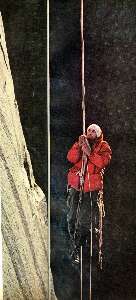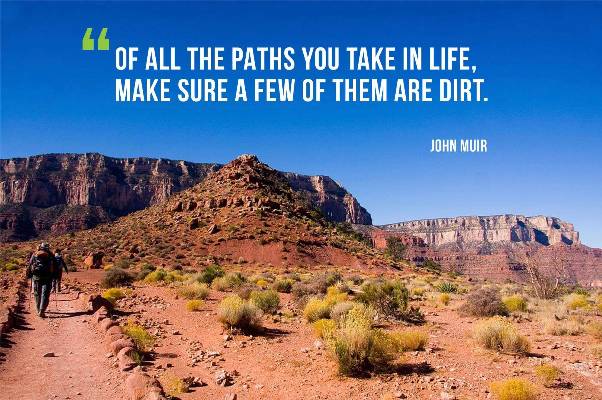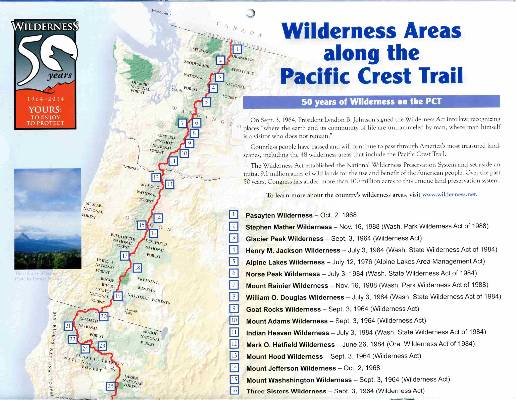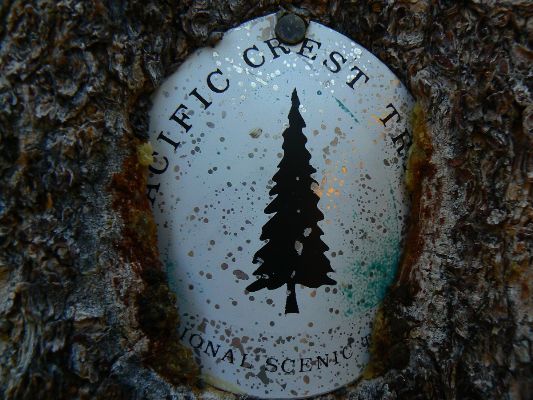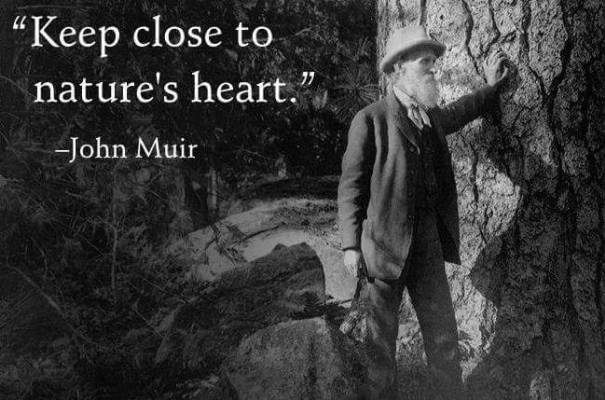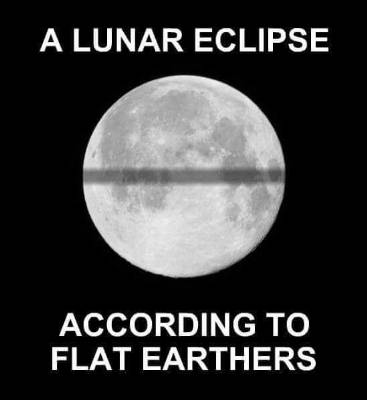Day 10: Treebeard to Brown Mountain Shelter. To near Brown Mountain Shelter:
PCT mile 1763.5. 12.4 miles. ERM = 19. Camp at 5250'.
The silky, cool, crisp, clear water curves from the pipe with a gentle burble.
Delightful. This water at Spring 1755.2 is most excellent water and the last until the possible water beyond
the Brown Mountain Shelter and maybe until the Fish Lake area.
And, this spring marks roughly 100 miles on this pygmy PCT adventure.
It's a day of trees and more trees; so many yuge trees that the solar
panel is struggling to get a decent charge. Many of the trees are festooned with strands of light green
moss, decked out like tinsel trees, without the glitter. Treebeard. I pause for a long break, partly to
get some sun on the panel.
When there is a gap in the tree cover, what do I see but Mount Shasta
gleaming serene.
After a long lunch #2 at a road crossing, urging the solar panel to do
its thing, I continue to Brown Mountain Shelter. Although I search for awhile, I cannot find a scenic
toilet near the shelter. Huh?
At the next road crossing, I find the fabled last water until the Fish
Lake/Hwy 140 area and a place to camp. According to notes by Optimistic Turtle, there is an eight mile
stretch of lava coming to the trail and starting in a half a mile from here.
As I'm goofing with the water. I meet and talk with
Desmond 29 Out of Germany, and Nutter Butter and Ham Bone.
It's growing cool as I clean up the dinnerware, so I hurry toward the
tent and bag at the end of this tenth day on the Pygmy PCT.
PCT 2018 - Seiad to Crater, Photos Day 10
Day 11: Lava Romp. To Fish Lake Resort (resupply):
PCT 1773.2. 9.7 miles (plus 2 miles access trail to the resort). 11.7 miles. ERM = 14. Camp at 4850'.
I have on all my clothes and hiking the dark treebeard forest, wondering
if the lava field supposedly ahead will allow the sun to heat my bones and other parts.
Along comes Pusher from Germany, teeth almost chattering. He pushes
on and I put my gloved hands in my pockets.
It does warm in the sun glinting off the black basalt. Lovely.
I hike awhile with Trish, Fire Woman and Paul, NoHawk (a geologist)
and NoHawk points out a collapsed lava tube.
Occasional Sugar Pine giganto-cones dot the lava swales and forest
incursions. NoHawk notes that these spiny rubble depressions were formed by the surface of the lava
cooling and the still hot magma underneath flowing out. Amazing diversity. Some might call this
area desolate, yet, as Trish points out, it is fascinating. And, the hours and effort to create this
trail are astounding. I enjoy my time with these hikers, yet we part ways at the side trail to Fish
Lake. So long and take care.
Something other than Mount Shasta appears; Mt McLoughlin. Hurrah.
I hike the path off the PCT to Fish Lake Resort for resupply, lunch,
charging phone and panel battery, and a shower. Reportedly, there are numerous mosquitoes back up on
the PCT near the canal (water source) and it's getting late in the day, so I lug the resupplied pack
plus water part way around Fish Lake to a camp with a moderate amount of bugs.
Mount McLoughlin is a steep-sided stratovolcano, or composite volcano,
in the Cascade Range of southern Oregon and within the Sky Lakes Wilderness. It is one of the volcanic
peaks in the Cascade Volcanic Arc, within the High Cascades sector.
I meet Matt at Fish Lake while I'm sorting out items from my resupply
box, charging the phone, eating a meal. Later, I'm camped with Matt on the bank of Fish Lake. Matt
is on a 40+day quest to answer some questions and escape the shallowness of the false bravado (facebook;
and their ilk). He shows a video of a Yosemite Bobcat with a squirrel it captured in front of his tent.
Amazing. Here's hoping that the same fate awaits all camp robbing furry-tailed rats.
PCT 2018 - Seiad to Crater, Photos Day 11
Day 12: Sky High Lakes. To Christi's Spring:
PCT mile 1784.9. 11.7 miles. (plus 2 miles up to the trail from the resort; 13.7 miles) 13.7 miles.
ERM = 16.7. Camp at 6290'.
As I approach the boundary of the Sky Lakes Wilderness, I meet
Allan and Lea, two energetic and positive people whom are delightful to meet and talk
with. They're camped along the rushing Cascade Canal and have enjoyed the background noise of this
creek, which is not far from the Hwy 140 crossing.
Mosquitoes occasionally ambush me on the trail and are
uncharacteristically absent at other times. The grade is up, up somewhere over a thousand feet
to the McLoughlin junction. Up more later.
Next, I encounter Angie and Dana, hiking with pupster.
They placed a food cache in a 5 gallon plastic bucket and a Bear, apparently, took a nip of it,
without getting to the food. Not a very determined Bear.
As I approach Twin Ponds junction, the mass of trees thins enough
to get a glimpse of conical Mt McLoughlin, but not much of a view. The map says that there are
lakes about, yet there are too many trees to see much of anything but trees. Twin Ponds/Summit
Lake junction is just right for lunch #2. Mosquitoes greet me, then mystically depart so I
enjoy a pleasant lunch.
The trail continues, slower now, to Christi's Spring where I find
Lea and Allan taking a break in their tent. Mosquitoville. They wrap up and continue to the Red
Lake diversion off into a lake basin and then back on the PCT while I filter water and backtrack
on the trail to a camp I hope hosts a moderate amount of bugs.
Along comes Matt and he also stays in this camp.
It's good to have a tent with full bug netting.
PCT 2018 - Seiad to Crater, Photos Day 12
Day 13: And Lucifer Preceded The Devil. To the first creek North
of Christi's:
PCT mile 1799.3. 14.4 miles. ERM of 22. Camp at 6756'.
A quartet of toads bark into the dawn, waking me, and I can tell they
also wake Matt. Time to get on the long trail for today.
The route starts through dense forest, then opens to a distant view of
what else but Mt Shasta, albeit more and more distant. Then comes a look at the other side of Mt McLoughlin.
The journey today then goes through a pass below Luther Mountain into a
whole new vista. First, of fire damage for about 2 miles, including the top of the trail steeply down
into the Snow Lakes. Initially, I planned to stay at a Snow Lake, yet looking down into the basin, I
think not. Besides, there's good flowing water predicted ahead. So, go for the creek North of the
planned stop.
The trail continues through the saddle below Lucifer, on the way to Devil
Peak before dropping into the basin where there is water, precious water. The vista opens more as the
PCT climbs nearly over Shale Butte, skirts part of Lucifer, and tops out near Devils Peak before dropping
past a rare diminutive snowbank to the creek at PCT 1799.3. Matt continues to one of the next water
stops, trying to get close to the land of Mazama. This camp features a ranging vista to beyond Crater
Lake, although I am not sure what I am seeing. Perhaps it is possible to see the edge of the caldera?
Anyway, it's an expansive and deluxe vista.
An orange fireball sunset closes out this long day, indicating that
there are fires in the area. When I'm almost asleep I smell smoke from the fire that contributes to
the saturated color of the orange fireball sunset.
PCT 2018 - Seiad to Crater, Photos Day 13
Day 14: Ghost Tree Graveyard. PCT mile 1810:
10.7 miles. ERM of 15.5. Camp at 6250'.
As I fish out the next three mosquitoes from the cocoa, the orange-pink
light fades to a blue-gray. It's morning on Day 14. I got up before dawn to attempt to photograph
the morning hue and I was ambushed by squadrons of mosquitoes.
Teetering down the trail with a full load, 7 liters, of water; because
of uncertainty about water at Jack Spring, seems like a necessary precaution.
I again see Matt, and as we are talking Bear from Michigan arrives and
we discuss the dangers of working for amoral immoral, I suppose most all of the, corporations.
A California Toad leaps into the trail and nearly underfoot. Here, I
believe, is the barking toad that interrupted the morning bliss of morning on Day 13.
A mosaic of burned and green areas appears about 1.7 miles South of the
Jack Creek Spring Trail, soon followed by a totally toasted section sporting weathered ghost trees.
Jack Spring Trail is in the toasted segment. So, I don't stop to check on the spring because the area
looks like a moonscape. A positive note, the mosquitoes don't like the area either. This is a grand
discovery because I have sufficient itching bumps on my body parts for the duration of the adventure.
It will be a mosaic of toasted and green sections for several miles and
I pick an untoasted place to camp. It's a section sporting Lodgepole Pines in the Oregon Desert (yes,
that's the official name on the map, Oregon Desert).
Perhaps I could jettison the extra water and hike fast to Mazama
Village, yet it's a bit late, hot, and I feel a responsibility to use the massive poundage of water
I've toted here.
There's a hint of smoke stink in the general overcast, and the clouds
again conspire to inhibit the solar system from obtaining a full charge. Two young women stop while
I am at lunch #3 to ask about the status of the Bend Fire. Maybe that's it?
So, I while away the remainder of the afternoon amidst a Lodgepole
Pine forest, checking these journal notes.
Wow, it's wonderful to camp without mosquitoes, here in the part of
the former forest labeled as "Oregon Desert" on the topo map.
PCT 2018 - Seiad to Crater, Photos Day 14
Day 15: Mazama Completion, For Now. To Mazama Village:
PCT mile 1821.7. 11.7 miles (plus 0.7 to the camp). ERM = 18. Camp at 6020'.
Starting out from the bug-free Oregon Desert, I suffer frozen toes;
they warm quickly once I'm hiking.
There's more hiking in the toasted obstacle course. As trees
clear, Union Peak juts up like a shark tooth. The burn has cleared openings for forbs and a delicious
Lupine aroma fills portions of the early walk.
And, it's a quiet trail; I see only one other hiker until I approach
Highway 62. I get off at the Annie Springs turn and to Mazama Village, completing the Mazama
Village - Penetrating Oregon - Pygmy PCT 2018. At least for now. Yes, I intended to hike through
the Park, to the North border, yet this was not to be.
Yet, this is another terrific jaunt on the Pacific Crest Trail,
hiking a backbone of America's public lands. Let's all walk free, with a government that protects
us from the ravages of evil corporations (most of this amoral, immoral cabal) everywhere.
A government of or elected by billionaires is not a government of the people. Hike on.
PCT 2018 - Seiad to Crater, Photos Day 15
Postlog:
I comb my hair at the entrance to Mazama Village and grab the
geezer pass (not needed, I'm already in the Park). I have mixed feelings, a paisley contrast of
emotions; it's good to be starting home to help, it's sad to be leaving the trail.
At the hiker/biker campsite, I again see Kyle and this time I
get his photo. He's temporarily off the trail because of an injured knee.
I set up at hiker/biker camp and enjoy a short shower. Wondrous.
Over for dinner at Annie's. I again see some of the hiker friends
from the trail while camping at the hiker/biker site in Mazama Village. Sad to say, I'll never again
hear from anyone I meet on the Trail this trip, and this makes me feel sad indeed.
The next morning I head to Burney - It's to the Green Gables Motel
because they did a wonderful job of storing the Subie last year. But first, I drive around the
rim of Crater Lake and visit most of the viewpoints. Spectacular, even though the vistas are
cluttered and muted by haze from the California border fire. Before I rocket out of the Park, I again
see Paul NoHawk and Trish Fire Woman at a Crater Lake overlook. Now this is a fitting pause to the
pursuit of the PCT.
Driving to Burney, the hulk of the ever present Mt Shasta looms in
the murk. Ever-present, it was slow getting to Shasta, and now it won't leave the views. Maybe
the approach to Washington will be sans Shasta?
Next day, to Tonopah. As I drift into California, I stop for scenic
toilet photos with Mts Lassen and Shasta as the scenic. There's a wistful wind at the vista,
prompting
fond memories of the Hat Creek Rim
Stopping at an unscenic toilet not far from the largest ammunition
depot in the world (Hawthorne Army Depot, near Hawthorne, NV; it's yuge - at 262 square miles), I
open the toilet door and a very aggravated tarantula wasp flies into me, stinging me on the ankle.
Amazingly, the sting feels excruciating for a few minutes, then calms and there is no lasting welt
or irritation. Certainly, reminiscing about the 2018 Pygmy PCT, Penetrating Oregon - a Mazama Meander
is filled with peasantries.
PCT 2018 - Seiad to Crater, Postlog Photos
.



















